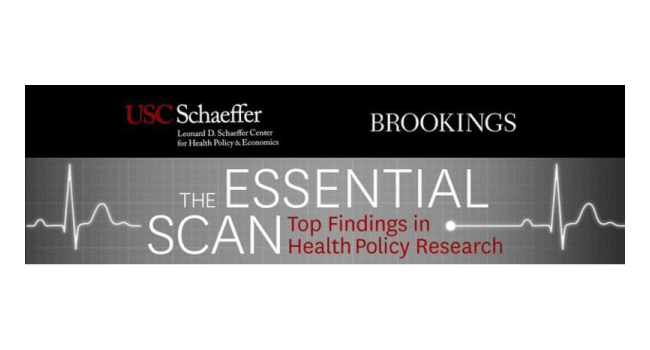What’s the latest in health policy research? The Essential Scan aims to help keep you informed on the latest research and what it means for policymakers. It is produced by the USC-Brookings Schaeffer Initiative for Health Policy, a collaboration between the Brookings Institution and the USC Schaeffer Center for Health Policy & Economics. To sign up to receive the Essential Scan straight to your inbox, sign up here.
Voluntary Regulation: Evidence from Medicare Payment Reform
Study by: Liran Einav, Amy Finkelstein, Yunan Ji, and Neale Mahoney
Government payment programs are frequently offered on an optional basis, allowing hospitals and provider systems to choose what works best for them. For example, Medicare implemented the bundled payment program for some joint replacements to provide a middle ground between fee-for-service (FFS) and fully capitated payment models. After mandating bundled payments to a group of hospitals for 2 years, these payments were made voluntary for half of the participating hospitals, which provided a rare opportunity to observe hospitals’ behavior under a model in which they could voluntarily choose to continue or discontinue bundled payments. Researchers found that voluntary participation was more likely for hospitals able to increase revenue without changing their behavior as well as for hospitals that made large changes when the program was mandatory. Given this opt-in bias, the researchers find the voluntary model is not effective in terms of reducing expenditures from the government to the hospital. It was estimated that if reimbursement was matched more closely to the claims level under FFS, these inefficient transfers could be reduced substantially. Full study here.
Out-of-Network Spending Mostly Declined in Privately Insured Populations with a Few Notable Exceptions from 2008 to 2016
Study by: Zirui Song, William Johnson, Kevin Kennedy, Jean Fuglesten Biniek, and Jacob Wallace
There have been relatively few studies and policy proposals focused on surprise medical billing that have focused on out-of-network care overall. A new study bridges this gap and assesses all out-of-network spending in employer-sponsored health insurance to identify trends in out-of-network billing over time. The researchers found the share of spending that occurred out of network decreased from 7 percent in 2008-2010 to 6.1 percent in 2014-2016. However, this decline did not apply to hospitalist services, pathologist services, and laboratory tests. The authors note that while concerns over surprise billing for emergency department visits (where patients have little choice) have led to policy efforts to address the problem, patients also have little choice of who provides their laboratory or hospitalist care also. They suggest surprise billing policies should extend to these care settings as well. Full study here.
The Value of Health Insurance During a Crisis: Effects of Medicaid Implementation on Pandemic Influenza Mortality
Study by: Karen Clay, Joshua A. Lewis, Edson R. Severnini, and Xiao Wang
Access to health insurance is widely viewed as being beneficial to an individual’s health. But there is some question as to whether it can save lives during a pandemic, as the high case volume caused by an outbreak may overwhelm medical resources, lowering the quality of care received. A new paper compares two influenza pandemics — the 1957-58 “Asian Flu” pandemic and the 1968-69 “Hong Kong Flu” pandemic — to determine the effect of access to Medicaid (established in 1965) on infant mortality rates during pandemics. Researchers found evidence of significantly reduced infant mortality during the 1968-69 flu, but the results were too large to be solely attributed to newly insured households accessing care. The authors suggest that better access to healthcare services for the newly eligible for Medicaid also helped to reduce local transmissions more broadly. As governments struggle to contain the spread of COVID-19, this study indicates that access to public insurance may help to mitigate the effect of current and future infectious disease outbreaks. Full study here.
Trends in Insulin Out-of-Pocket Costs and Reimbursement Price Among U.S. Patients with Private Health Insurance, 2006-2017
Study by: Amir Meiri, Fang Zhang, Dennis Ross-Degnan, and Frank Wharam
Out-of-pocket insulin costs have received increasing attention by policymakers and the public, a trend reflected in headline-grabbing stories of patients rationing the drug which has been on the market for almost a century. A new study analyzes insulin out-of-pocket costs and reimbursement prices from 2006 to 2017 among commercially-insured patients with three types of insurance: high-deductible health plans with health savings accounts (HDHP-HSA), health reimbursement arrangement (HRA), and general plans with no savings account. They found insulin out-of-pocket costs remained relatively flat during the study period, increasing from $52 per-member per-month in 2006 to $72 in 2013, before decreasing to $64 in 2017. HDHP-HSA members paid significantly more throughout the period studied, with costs following a similar trajectory of peaking in 2014 at $150 before decreasing slightly to $141 in 2017. According to the researchers, these findings suggest privately-insured patients have been relatively shielded from insulin price increases in recent decades and commercial health insurers have instead increased premiums or deductibles for all members. While the authors did not attempt to explain why patients with no-account plans fared so much better than those with high deductibles and savings accounts, it is likely a reflection that other types of cost sharing, such as copayments or coinsurance protect patients against all or most of the price increases. These findings have implications for policymakers as they consider how to address the high and rising costs of insulin. Full study here.
Click here to receive The Essential Scan email.
The Essential Scan is produced by the USC-Brookings Schaeffer Initiative for Health Policy, a collaboration between the Brookings Institution and the USC Schaeffer Center for Health Policy & Economics.
